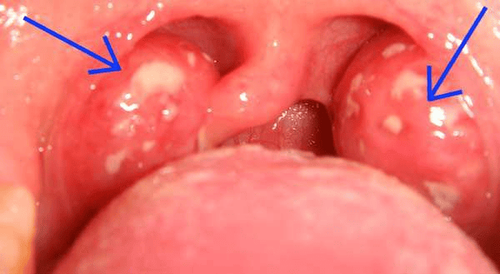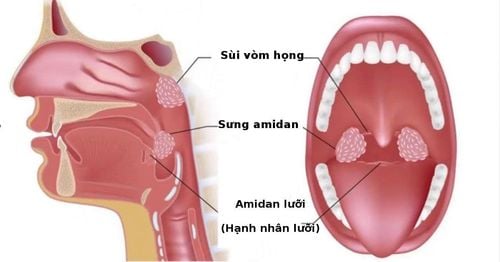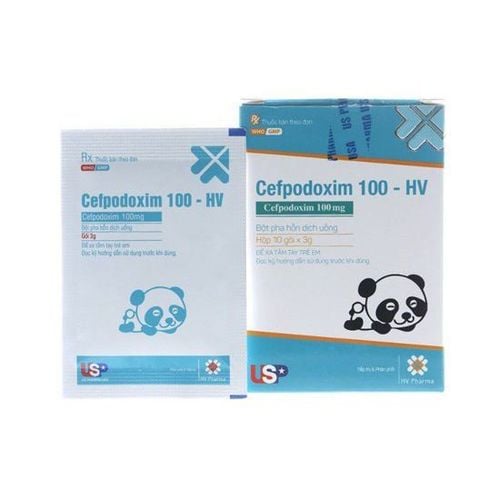This is an automatically translated article.
Peritonsillar abscess is a festering of loose connective tissue outside the tonsil capsule. The disease can occur at any age, but is most common in young adults or adolescents. Abscesses around the tonsils can cause pain, swelling and, worse, can clog your throat making it difficult to swallow, speak, or even breathe.
1. What causes an abscess around the tonsils?
Abscesses around the tonsils are often caused by bacteria that cause pharyngitis and tonsillitis. If the infection is not treated and spreads, it can lead to an abscess.
The most common bacteria that cause abscesses around the tonsils is streptococcus. This type of bacteria usually infects the soft tissues around the tonsils, usually on one side. These tissues will be attacked by anaerobic bacteria and penetrate the glands to form an abscess. In addition, certain other infections also increase the risk of abscess formation around the tonsils including:
Tooth infection Gingivitis Periodontitis Chronic tonsillitis Mononucleosis Chronic Lymphocytic Leukemia Besides For these reasons, smoking and breathing polluted air also increase the risk of abscesses around the tonsils.
Tonsillitis is a disease that easily recurs at the change of seasons, when the weather changes, when going out in the cold for too long without protection to keep the body warm, especially the throat area, which leads to an increase in pressure. car around the tonsils when the weather changes.
2. Abscess around the tonsils when do you need to see a doctor?
You need to see a doctor when tonsillitis is in the following condition:
When you have symptoms of a sore throat accompanied by fever, you need to see an ENT specialist to be checked for an abscess around the tonsils. or not. If you have a sore throat accompanied by difficulty swallowing, breathing, difficulty speaking, drooling or any other signs, you should go to the nearest hospital or medical facility. You absolutely should not arbitrarily treat abscesses around the tonsils at home.

Khi viêm áp-xe amidan gây sốt đau họng bạn nên gặp bác sĩ chuyên khoa
3. How to diagnose abscess around tonsils?
3.1. Determining the diagnosis of peritonsillar abscess To diagnose a peritonsillar abscess, it is necessary to rely on clinical symptoms and subclinical symptoms. Clinical symptoms to diagnose peritonsillar abscess include:
Functional symptoms include:
One-sided pain in the throat, oblique pain in the ear, pain increasing when swallowing or speaking. Difficulty swallowing, difficulty opening mouth. Stagnant saliva, bad breath. Physical symptoms include:
There is an infectious syndrome. Limited mouth opening. Swollen tissue around the tonsils: Swollen anterior casts push the tonsils inward and backward in the anterior body (common) or the swollen posterior column pushes the tonsils anteriorly in the posterior body, which is less common. The tongue is edematous and deviated. The tonsils often have pus on the surface. Angle nodes of the jaw are painfully swollen. Subclinical symptoms to diagnose peritonsillar abscess include:
Subclinical methods for diagnosing peritonsillar abscess:
Direct examination, culture, making antibiotic charts from tonsil pus or abscess pus. Blood culture, antibiogram if sepsis is suspected. Laboratory methods for the treatment and monitoring of peritonsillar abscess:
Peripheral blood count, in which the leukocyte count is often elevated. Blood clotting tests. Test for HIV, HBsAg, HCV when exposure is suspected. Blood biochemical tests: Urea, creatinine, protein, albumin, GOT, GPT, blood sugar, electrolytes, CRP. Urine analysis. Cardiopulmonary X-ray. 3. 2. Differential diagnosis Peritonsillar abscess needs to be differentiated from the following diseases:
Tumor of the side of the pharynx, tonsil cancer

Tình trạng viêm áp-xe amidan cần được chẩn đoán phân biệt với ung thư Amidan
4. Treatment of abscess around tonsils
4.1. Principles of treatment of tonsil abscess Using high-dose broad-spectrum antibiotics. Inject drainage when the abscess has pus. 4.2. Treatment of specific peritonsillar abscess 4.2.1. Medical treatment Antibiotics: Usually one of the following drugs is used, the duration of the drug is 7-10 days. Cefotaxime x 1g/time x 3 times/day, intravenously for 3-5 minutes, every 8 hours. Ciprofloxacin x 400mg / time x 2 times / day, intravenous infusion over 60 minutes, 12 hours apart. Combined with the drug Gentamicin x 5-7 mg/kg/time x 1 time/day, intramuscularly. Pain relief, fever reducer: Usually one of the following drugs is used, which can be combined with drugs when the pain is severe. Paracetamol x 0.5 - 1g/time x 2 - 4 times/day, orally or intravenously. Piroxicam x 20mg x 1 time, intramuscular injection. Anti-inflammatory: Methylprednisolone 40mg, slow intravenous injection in the morning for 3-5 days. Sedation: Diazepam 5 mg, orally in the evening x 3 - 5 days. Rehydration and electrolytes for cases of severe pain causing poor eating: Oresol, intravenous fluids. 4.2.2. Incision to drain the abscess around the tonsils When there is evidence of pus after being treated with antibiotics. Inject, wash the abscess and place drainage gauze. If 1 day after draining the abscess, there is still a fever, blood cultures and antibiotics should be done. If after 5 days of treatment, the disease does not improve, it is necessary to repeat hematological, biochemical and bacteriological tests. Repeat chest X-ray to look for associated lesions.
4.3. Diet and hygiene during the treatment of peritonsillar abscess During the treatment of peritonsillar abscess, you should eat liquid, soft, easily digestible foods and gradually eat solid foods when pain is relieved.
Hygiene, pain relief to prevent complications, restore function during the treatment of peritonsillar abscess:.
Body hygiene. Daily suction, wash, change the gauze to drain the abscess within 3 days. Gargle with 0.9% sodium chloride solution 6-8 times a day. After finishing treatment, you need to clean your teeth, gargle with salt water several times a day, examine and treat tooth decay, and need to remove tonsils after 1-2 months.

Người bị viêm áp-xe amidan nên súc họng bằng Natri clorid 0,9%
5. How to prevent abscess around tonsils?
Increase the body's resistance, keep the environment clean. Limit risk factors such as: Don't smoke, limit exposure to smoke, keep good oral hygiene, ... When you have sore throat, tonsillitis needs to be treated early and thoroughly to avoid other complications. symptoms. Do not arbitrarily buy medicine for treatment or use the wrong medicine, not the right way to use as well as the time to take it as prescribed by the doctor. Keep your throat clean by regularly rinsing your mouth and throat with mild alkaline solutions, eating hygienically, and paying attention to keeping your body warm when it's cold. Knowing the information about tonsillitis will help you provide timely treatment and an appropriate self-care plan.
Vinmec International General Hospital specializes in the examination and treatment of common nasopharyngeal diseases, head and neck tumors, congenital malformations of the ear, nose and throat area with the most optimal internal - surgical methods. for patients, both children and adults. Coming to Vinmec International General Hospital, patients will receive a direct, dedicated and professional examination from a team of qualified and experienced medical staff.
Please dial HOTLINE for more information or register for an appointment HERE. Download MyVinmec app to make appointments faster and to manage your bookings easily.













